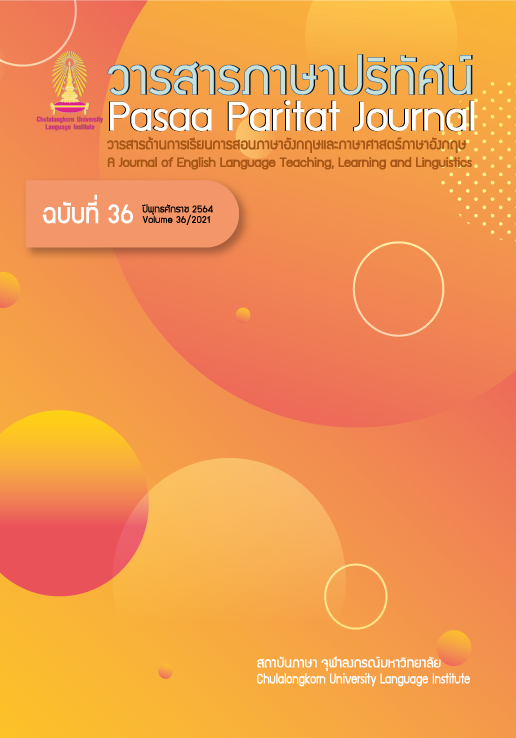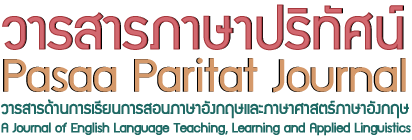Voices of ASEAN Teachers of English regarding Target Variety Issues of English as the Official Language of the ASEAN Community
DOI:
https://doi.org/10.58837/CHULA.PPJ.36.3คำสำคัญ:
การสอนภาษาอังกฤษในอาเซียน, เจตคติของผู้สอน, รูปแบบภาษาเป้าหมาย, ภาษาอังกฤษในฐานะภาษานานาชาต, ภาษาอังกฤษในฐานะภาษากลางในการสื่อสาร, ELFบทคัดย่อ
งานวิจัยนี้ศึกษาเรื่องรูปแบบของภาษาอังกฤษ (varieties of English) และ โมเดลที่ใช้ในการเรียนการสอนภาษาอังกฤษ บทบาท และ ความขัดแย้งของภาษาอังกฤษในบริบทประชาคมอาเซียน การศึกษาครั้งนี้ใช้แบบสอบถามผู้สอนภาษาอังกฤษ จ านวน 374 คน และการสัมภาษณ์กลุ่ม 6 ครั้ง รวมผู้เข้าร่วมการสัมภาษณ์ 28 คน โดยให้ผู้ตอบแบบสอบถามอธิบายถึงเจตคติในเรื่องรูปแบบของภาษาอังกฤษที่ตนเรียน สาเหตุที่เรียนภาษาอังกฤษและเหตุที่
ภาษาอังกฤษถูกน ามาสอนในบริบทของผู้ตอบ รูปแบบของภาษาอังกฤษที่ผู้ตอบแบบสอบถามใช้สอน ปัจจัยที่มีผลต่อการเลือกสอนภาษาอังกฤษในรูปแบบดังกล่าว และ รูปแบบของภาษาอังกฤษที่ผู้ตอบคาดว่าจะสอนในอนาคต ในการสัมภาษณ์กลุ่ม ผู้เข้าสัมภาษณ์ได้แบ่งปันแนวคิดเรื่องรูปแบบมาตรฐานภาษาอังกฤษ และให้ค านิยามของรูปแบบของภาษาอังกฤษแบบอังกฤษ แบบอเมริกัน ภาษาอังกฤษในฐานะภาษานานาชาติ (EIL) และ ภาษาอังกฤษในฐานะ
ภาษากลางในการสื่อสาร (ELF) จากข้อมูลพบว่า ผู้สอนภาษาอังกฤษแสดงความเชื่อถือในรูปแบบภาษาอังกฤษแบบอังกฤษและอเมริกันเป็นอย่างยิ่งซึ่งขัดแย้งกับสภาพความเป็นจริงด้านภาษาศาสตร์ในภูมิภาค มีการกล่าวถึงเรื่องอัตลักษณ์ เรื่องการเป็นผู้สอนแบบเจ้าของภาษาและไม่ใช่เจ้าของภาษา และ ความเป็นเจ้าของภาษาอังกฤษ ส่วนการให้ค านิยามของภาษาอังกฤษในฐานะภาษานานาชาติ และ ภาษาอังกฤษในฐานะภาษากลางในการสื่อสารนั้นยังไม่ชัดเจน
การศึกษาครั้งนี้ปิดท้ายด้วยการอภิปรายผลเพิ่มเติมในการปรับแนวคิดเรื่องการเรียนการสอนภาษาอังกฤษเพื่อให้สอดคล้องกับบริบทโลกาภิวัฒน์ในปัจจุบันและในอนาคต
เอกสารอ้างอิง
Borg, S. (2003). Teacher cognition in language teaching: A review of research on what language teachers think, know, believe, and do.
Language teaching, 36(02), 81-109.
Borlongan. (2009). A Survey on Language Use, Attitudes, and Identity in Relation to Philippine English among Young Generation Filipinos: An Initial Sample from a Private University. Philippine ESL Journal, 3(August), 74-107.
Darasawang, P., & Watson Todd, R. (2012). The effect of policy on English language teaching at secondary schools in Thailand. In E.-L. Low, Hashim, A (Ed.), English in Southeast Asia: Features, policy and language in use (pp. 207-220): John Benjamin.
David, M. K., & Dumanig, F. (2008). Nativization of English in Malaysia and the Philippines as Seen in English Dailies. Philippine Journal of Linguistics, 39.
Evans, B. E., & Imai, T. (2011). ‘If we say English, that means America’: Japanese students’ perceptions of varieties of English. Language
Awareness, 20(4),315-326.
Farrell, T. S., & Kun, S. T. K. (2008). Language policy, language teachers' beliefs, and classroom practices. Applied Linguistics, 29(3), 381-403.
Graddol, D. (2003). The decline of the native speaker. Translation today: Trends and perspectives, 152-167.
Jenkins, J. (2006). Current perspectives on teaching world Englishes and English as a lingua franca. TESOL Quarterly, 40(1), 157-181.
Jenkins, J. (2009). World Englishes: A resource book for students (2 ed.): Routledge.
Jindapitak, N., & Teo, A. (2010). Thai in Blood, American in Taste: English Learners’ Preferences for Varieties of English. Paper presented at the 2nd International Conference on Humanities and Social Sciences, Prince of Songkla University, Thailand.
Jones, M. E. (2004). Forging an ASEAN identity: The challenge to construct a shared destiny. Contemporary Southeast Asia: A Journal of
International and Strategic Affairs, 26(1), 140-154.
Kachru, B. B. (1992). World Englishes: Approaches, issues and resources. Language teaching, 25(01), 1-14.
Kieu, K. A. H. (2010). Use of Vietnamese in English language teaching in Vietnam: attitudes of Vietnamese university teachers. English Language Teaching,3(2), p119.
Kirkpatrick, A. (2000, 23 November, 2000). English as an Asian language, It is time for East and Southeast Asia to learn its own version of English, argues Andy Kirkpatrick, Education. The Guardian Weekly. Retrieved from
https://www.theguardian.com/education/2000/nov/23/tefl.guardianweekly
Kirkpatrick, A. (2011). English as an Asian lingua franca and the multilingual model of ELT. Language teaching, 44(02), 212-224.
Kirkpatrick, A. (2014). English in Southeast Asia: Pedagogical and policy implications. World Englishes, 33(4), 426-438.
Kurland, R. (1991). The classroom teacher and the role of authority. Journal of Teaching in Social Work, 5(2), 81-94.
Li, L., & Walsh, S. (2011). ‘Seeing is believing’: looking at EFL teachers’ beliefs through classroom interaction. Classroom discourse, 2(1), 39-57.
ดาวน์โหลด
เผยแพร่แล้ว
เวอร์ชัน
- 2023-07-14 (4)
- 2022-04-12 (3)
- 2022-04-12 (2)
- 2021-01-01 (1)
รูปแบบการอ้างอิง
ฉบับ
ประเภทบทความ
สัญญาอนุญาต

อนุญาตภายใต้เงื่อนไข Creative Commons Attribution-NonCommercial-NoDerivatives 4.0 International License.



